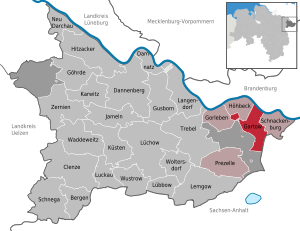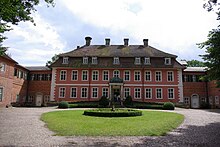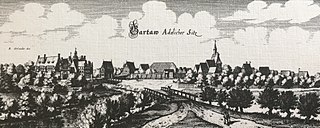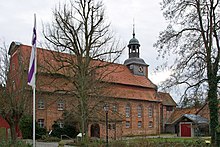Gartow
| coat of arms | Germany map | |
|---|---|---|

|
Coordinates: 53 ° 1 ' N , 11 ° 27' E |
|
| Basic data | ||
| State : | Lower Saxony | |
| County : | Lüchow-Dannenberg | |
| Joint municipality : | Gartow | |
| Height : | 17 m above sea level NHN | |
| Area : | 28.27 km 2 | |
| Residents: | 1446 (Dec. 31, 2019) | |
| Population density : | 51 inhabitants per km 2 | |
| Postal code : | 29471 | |
| Area code : | 05846 | |
| License plate : | DAN | |
| Community key : | 03 3 54 005 | |
| LOCODE : | DE 75W | |
| Community structure: | 3 districts | |
| Address of the municipal administration: |
Springstrasse 14 29471 Gartow |
|
| Website : | ||
| Mayor : | Magda Geldmacher ( UWG ) | |
| Location of the municipality of Gartow in the Lüchow-Dannenberg district | ||
Gartow is a stain in Lüchow-Dannenberg in Lower Saxony and also the headquarters of gartow .
There is also a municipality-free area of the same name near the municipality of Gartow.
geography
Gartow is located in the historic Wendland landscape on the western bank of the Seege , a left tributary of the Elbe, which expands north of Gartow into an artificially dammed lake in the 1970s. The place is located in the Gartower Elbmarsch area within the Lower Saxony Elbe Valley . A large area of pine forest, the Gartower Tannen , extends southwest . The highest point, the Hahnenberge , is 32 m.
The B 493 runs through the village between Lüchow and Schnackenburg .
Community structure
The spot is made up of the three districts
history
Older story
Already in the younger Stone Age (4000–2000 BC) people settled in the Gartower area, as indicated by stone hatchets and stone axes that have been found. Other finds from the Bronze Age and Iron Age prove that settlement activity lasted for thousands of years.
Around 800 the Gartow area got into armed conflict between Franks , Slavs and Saxons and was then subjugated by the Frankish emperor Charlemagne .
In the early Middle Ages , Germans and Wends immigrated from the east lived here peacefully.
Gartow Castle and Estate
Although the city of Schnackenburg became more important as a customs post than Gartow, there was probably a lock in Gartow since 1225 against Slavic efforts to exert influence here. In this year, a Conrad von Gartow was mentioned for the first time. The gentlemen of Gartow were fortunate to have a number of properties that were in the immediate and wider vicinity of Gartow. The former Gartow Castle consisted of an outer and main castle and was surrounded by a moat .
At that time Gartow was with several surrounding places in the area of influence of the Mark Brandenburg and was counted to the Altmark. The Principality of Lüneburg also laid claim to this area. In 1360 Gartow was sold to the Order of St. John , who established the Kommende Gartow here by 1371 at the latest . When the order sold Gartow to the Dannenberg knights von Bülow and von der Schulenburg in 1438 , Brandenburg again made claims. For more than a century, the von Bülows managed to use the conflicting feudal interests of the Guelph and Ascanian princely houses for their own benefit and to round off their property through a clever policy of purchase and pledge. Today's Gartower local coat of arms is derived from the Bülow family coat of arms.
Andreas Gottlieb von Bernstorff bought the badly dilapidated and neglected Bülow property in 1694 after he had enforced the renunciation of all claims by the House of Brandenburg as Minister of the Brunswick-Lüneburg Prince. He led the town of Gartow to an economic boom and with it the entire surrounding rural area, which was increasingly oriented towards Gartow.
1721 and 1764 Gartow was hit by major fires. After the first major fire in 1721, Gartow was completely redesigned. In 1724 the St. George Church was built in the baroque style, from 1710 to 1727 the Gartow Castle was rebuilt.
In terms of administrative policy, von Bernstorff was able to achieve the creation of a so-called "Closed Aristocratic Court Gartow" in 1720. The administration and jurisdiction of Gartow and 24 villages was carried out from Gartow, where the von Bernstorff family had all administrative tasks done in accordance with state law. Before that, the villages of Holtorf, Kapern and Gummern were ceded to the Electorate of Hanover and placed under the administration of the "Gartow Closed Court".
In the wake of political decisions in 1850 the administration and judiciary were separated and at the same time new official regulations were announced, according to which all previous aristocratic courts had to be dissolved, including Gartow's. On July 15, 1850, a new Gartow office was founded. The former Schnackenburg office had ceased to exist.
With this change, the Bernstorff family's influence worsened considerably. In addition, there was the legal release of obligations towards the Gartow house, which had been carried out by law since 1831. Only their own agriculture and forestry remained as a source of income . The property, one of the largest forest estates in Lower Saxony, is still managed today by Count Bernstorff . Fried Graf von Bernstorff is a business economist. Like his father Andreas Graf von Bernstorff, he is an opponent of the planned nuclear waste repository in Gorleben .
Younger story
In the course of further administrative reforms in 1872, the Gartow office was integrated into the Lüchow office, which was later renamed the Lüchow district, and now finally no longer existed. From 1945 to 1989, the Gartow area was part of the border area . In the course of the administrative and territorial reform in 1972, the Gartow joint municipality was formed with its seat in Gartow.
In 1974, construction work began on the Gartow-Nienwalde sea dike ; Most of the soil required for this comes from the lowland between Gartow and Restorf . The 67 hectare Gartower See was created there by damming the Seege .
Today the area of the municipality Gartow is 184.76 km², on which about 4100 inhabitants live.
religion
The Evangelical Lutheran parish of Gartow shares a parish with the neighboring parishes of Meetschow, Vietze, Holtorf, Kapern, Restorf and Schnackenburg . They have joined forces in the parish on the Elbe and Seege . The pastor Eckhard Kruse is the representative for repository issues of the regional church Hanover . The counts of Bernstorff continue patron of the parish Gartow and churches to Prezelle , Restorf and Trebel .
Incorporations
On July 1, 1972, the municipalities of Laasche and Nienwalde were incorporated.
Explanation of the place name
Old names of the place are 1255 Garttowe, 1319 Gartowe, 1364 Ghartow and around 1462 Gartow. There are assumptions that the place name is of Slavic origin, identical to the Polish place name Chartowo (this goes back to the dog breed greyhound, "chart" means "greyhound"). Gartow probably goes back to the name of the water body, Garte.
politics
The Gartow area belongs to the state electoral district 48 Elbe and to the federal electoral district 38 Lüchow-Dannenberg - Lüneburg .
Municipal council
The council of the municipality has eleven members who have been divided into the following parties and electoral associations since the local elections in Lower Saxony in 2016 :
- CDU : 5 seats (=)
- UWG : 3 seats (−1)
- SPD : 2 seats (=)
- Alliance 90 / The Greens : 1 seat (+1)
mayor
Ulrich von Mirbach (UWG) has been the mayor of Gartow since November 15, 2011.
Culture and sights
In the list of architectural monuments in Gartow are the architectural monuments Gartow. The main street is the largest architectural monument in the area .
church
St. George's Church was built in Baroque style in 1724 after the previous Gothic building burned down. The interior impresses with its baroque-Protestant harmony. The raised choir in the east with a pulpit altar and surrounding galleries is decorated in white and gold.
The organ in the church is important, built in 1740 by Johann Matthias Hagelstein . Hagelstein built his only instrument in Gartow . The organ has been preserved in its original condition and has a very peculiar sound, which, on the occasion of the restoration by the Hillebrand company in 1991, was largely able to be traced back to a verifiable original condition.
Other structures
In Höhbeck near Gartow was the radio and directional radio transmission station Gartow , which was also referred to as the radio transmission station Höhbeck. This system had two antenna supports, 324 m and 344 m high. On August 20, 2009, the smaller transmission mast, Gartow 1, was blown up. The Gartow 2 transmission mast is still in operation. During the division of Germany into two parts, almost half of all telephone connections between the Federal Republic and West Berlin were handled via the 133 km long radio link to Berlin-Frohnau .
Economy and Infrastructure
tourism
Gartow is a climatic health resort . As an attraction for tourists, Gartow has camping and water sports facilities at Gartower See and its location in the Elbtalaue biosphere reserve with the Wendland thermal baths, as well as a larger indoor and outdoor pool with a thermal brine pool.
Every year, around 175,000 overnight stays are registered in the Gartow municipality.
Personalities
Sons and daughters of the place
- Adolf Ellissen (* 1815 in Gartow; † 1872 in Göttingen), politician, philologist and historian, son of Gerhard Ellissen.
- Georg Ernst Graf von Bernstorff (* 1870 in Gartow; † November 10, 1939 in Ludwigslust), landowner and politician (DHP), member of the Reichstag.
- Wolfgang Ehmke (born September 25, 1947 in Gartow), opponent of nuclear power and longstanding spokesman for the Lüchow-Dannenberg environmental protection initiative .
Personalities who have worked in the place
- Andreas Gottlieb von Bernstorff (* 1649; † 1726 in Gartow), acquired the Gartow estate in 1694 and had a new castle built in 1709.
- Johann Georg Keyßler (* 1693; † 1743) was employed from 1716 to educate Johann Hartwig Ernst von Bernstorff and his brother Andreas Gottlieb the Younger; he expanded the count's library.
- Friedrich Gottlieb Klopstock (* 1724; † 1803) visited Count Andreas Gottlieb the Younger von Bernstorff in Gartow several times.
- Gerhard Ellissen (* 1778 in Northeim; † 1838 in Gartow), lived and worked for many years from 1814 as a doctor in Gartow; Father of Adolf Ellissen.
- Bechtold von Bernstorff (* 1803; † 1890 in Gartow), 1877–1890 member of the German Reichstag for the constituency of Uelzen-Gartow.
- Berthold von Bernstorff (* 1842; † 1917), 1869–1883 forest manager in Gartow, 1893–1907 member of the German Reichstag for the Lüchow-Uelzen constituency.
- Carl Junack (* 1870; † 1943), German forester, inventor and publicist
- Karl May (* 1842; † 1912) stayed in town for some time on a trip in 1898. He lived in the Hotel Krug at 15 Hauptstrasse. He was immediately the social center of the place. After being arrested, he traveled quickly on May 7, 1898. The Gartow police found him suspicious because he had given generously to a poor family.
- Hermann Junack (born September 6, 1912 in Neudeck, Upper Silesia , today Świerklaniec , Poland ; † September 26, 1992 in Gartow), headed the Gartow private forest office from 1941 to 1979 under the administration of the Count von Bernstorff and developed the Gartow Forest during this time to an example company for the "natural forest management".
- Alexander Stahlberg (born September 12, 1912 in Stettin ; † January 9, 1995 in Neukirchen-Vluyn ), lived in Gartow from 1989 and performed in readings and lectures in the region.
- Iris Bethge (born December 12, 1969), Managing Director of the Association of German Banks, grew up in Gartow.
Web links
Individual evidence
- ↑ State Office for Statistics Lower Saxony, LSN-Online regional database, Table 12411: Update of the population, as of December 31, 2019 ( help ).
- ↑ Statistics of the German Reich, Volume 450: Official municipality directory for the German Reich, Part I, Berlin 1939; Page 265
- ↑ http://www.taz.de/1/zukunft/umwelt/artikel/1/adel-verzierter/
- ^ Parish website , accessed December 2, 2012.
- ^ Regional Church rejects criticism of the commissioning of repository issues , epd July 13, 2009, accessed on December 2, 2012.
- ↑ Portrait of the Church ( Memento of the original from March 4, 2016 in the Internet Archive ) Info: The archive link was inserted automatically and has not yet been checked. Please check the original and archive link according to the instructions and then remove this notice. , accessed December 3, 2012.
- ^ Federal Statistical Office (ed.): Historical municipality directory for the Federal Republic of Germany. Name, border and key number changes in municipalities, counties and administrative districts from May 27, 1970 to December 31, 1982 . W. Kohlhammer, Stuttgart / Mainz 1983, ISBN 3-17-003263-1 , p. 231 .
- ^ Jürgen Udolph (research): The "place name researcher". In: website NDR 1 Lower Saxony . Archived from the original on December 2, 2016 ; accessed on August 4, 2019 .
- ↑ Archived copy ( memento of the original from January 2, 2017 in the Internet Archive ) Info: The archive link was inserted automatically and has not yet been checked. Please check the original and archive link according to the instructions and then remove this notice.
- ^ Ernst-Günther Behn: Das Hannoversche Wendland - churches and chapels , Lüchow 2011, pages 56 ff.
- ↑ Elbe-Jeetzel-Zeitung : "Tolerance and Weltlaufigkeit", report on a scientific conference on "Keyßler's World", June 17, 2015, p. 5.
- ↑ Axel Kahrs : Wendland Literarisch, Göttingen 1985, pp. 20 ff.
- ↑ Axel Kahrs : Wendland literarisch, Göttingen 1985, p. 49 ff.
- ↑ Wendland-Lexikon, Volume 2, Lüchow 2008, pp. 441f.







